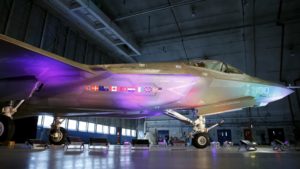
F-35 fighter jet
Credit: Gary Cameron/Reuters
The U.S. Air Force has grounded a quarter of its new F-35 stealth fighters after five pilots reported symptoms consistent with oxygen-deprivation.
The flight restriction, which affects 55 of the roughly 200 F-35s in service, has alarmed experts. They worry that, as the Air Force buys more and more F-35s, future groundings could affect a wide swath of the military’s fighter fleet.
But the Air Force is trying to put on a brave face on the problem. Service officials insist the Air Force will always have other options if its F-35s become unflyable.
Above 10,000 feet or so, the air thins out. A pilot flying above that altitude must breathe oxygen through a mask—or risk hypoxia. But if the mask or its attached filter malfunctions, the flier can still suffer hypoxia-like symptoms. Dizziness. Confusion. Even blackouts.
In recent years the U.S. military has struggled with hypoxia problems on many of its aircraft, including F-22 stealth fighters, T-45 training jets, and F/A-18 naval fighters.
The five F-35 pilots, all […]










